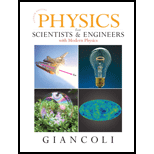
Concept explainers
How large would the Sun be if its density equaled the critical density of the universe,
Want to see the full answer?
Check out a sample textbook solution
Chapter 44 Solutions
Physics for Scientists and Engineers with Modern Physics
Additional Science Textbook Solutions
Tutorials in Introductory Physics
University Physics with Modern Physics (14th Edition)
The Cosmic Perspective Fundamentals (2nd Edition)
College Physics: A Strategic Approach (3rd Edition)
Physics for Scientists and Engineers: A Strategic Approach, Vol. 1 (Chs 1-21) (4th Edition)
University Physics (14th Edition)
- How many galaxies like our own would it take if they were placed edge-to-edge to reach the nearest galaxy? (Hint: See Problems 11 and 12.)arrow_forwardI asked the following question and was given the attached solution: Suppose that the universe were full of spherical objects, each of mass m and radius r . If the objects were distributed uniformly throughout the universe, what number density (#/m3) of spherical objects would be required to make the density equal to the critical density of our Universe? Values: m = 4 kg r = 0.0407 m Answer must be in scientific notation and include zero decimal places (1 sig fig --- e.g., 1234 should be written as 1*10^3) I don't follow the work and I got the wrong answer, so please help and show your work as I do not follow along easily thanksarrow_forwardThe sun orbits the center of the Milky Way galaxy for a period of 2.5x10^8 years. (a) Assuming a circular orbit of radius 2.4x10^20 m, compute the mass of the Milky Way. (b) Estimate the number of stars in the Milky Way, assuming the average star mass equals the mass of the sun—2.0x10^30 kgarrow_forward
- The geometry of spacetime in the Universe on large scales is determined by the mean energy density of the matter in the Universe, ρ. The critical density of the Universe is denoted by ρ0 and can be used to define the parameter Ω0 = ρ/ρ0. Describe the geometry of space when: (i) Ω0 < 1; (ii) Ω0 = 1; (iii) Ω0 > 1. Explain how measurements of the angular sizes of the hot- and cold-spots in the CMB projected on the sky can inform us about the geometry of spacetime in our Universe. What do measurements of these angular sizes by the WMAP and PLANCK satellites tell us about the value of Ω0?arrow_forwardmathematician Archimedes, responding to a claim that the number of grains of sand was infinite, calculated that the number of grains of sand needed to fill the universe was on the order of 1063. Our understanding of the size of the universe has changed since then, and we now know that the observable universe alone is a sphere with a radius of 1026 m. Estimating the size of a grain of sand, A) Approximately how many grains of sand would fill the observable universe? B) How many times larger or smaller is this number than Archimedes' result?arrow_forwardAstronomers believe that the universe is expanding and that stellar objects are moving away from us at a radial velocity V proportional to the distance D from Earth to the object. (a) Write V as a function of D using H as the constant of proportionality. V = (b) The equation in part (a) was first discovered by Edwin Hubble in 1929 and is known as Hubble's law. The constant of proportionality H is known as Hubble's constant. The currently accepted value of Hubble's constant is 70 kilometers per second per megaparsec. (One megaparsec is about 3.086 x 1019 kilometers.) With these units for H, the distance D is measured in megaparsecs, and the velocity V is measured in kilometers per second. The galaxy G2237 + 305 is about 122.7 megaparsecs from Earth. How fast is G2237 + 305 receding from Earth? km/sec (c) One important feature of Hubble's constant is that scientists use it to estimate the age of the universe. The approximate relation is 1012 where y is time in years. Hubble's constant is…arrow_forward
- Approximate values of length (in meters) 107 Diameter of Earth 1011 Distance from Earth to Sun 1016 Distance traveled by light in one year 1021 Diameter of the Milky Way Galaxy 1022 Distance from Earth to the nearest galaxy 1025 Distance from Earth to the edge of the known universearrow_forwardWhat would be your estimate for the age of the universe if you measured Hubbleʹs constant to be 33 km/s/Mly? You can assume that the expansion rate has remained unchanged during the history of the universe.arrow_forwardThe distance of a galaxy is of the order of 1025 m. Calculate the order of magnitude of time taken by light to reach us from the galaxy.arrow_forward
- Using a single dimensional equation, estimate the number of steps it would take a person with a step length of 2.65 ft to walk from the Earth to Alpha Centauri a distance of 4.37 light-years. The speed of light is 1.86282 x 105 miles/s. Number of Steps = Enter your answer in accordance to the question statement x 1017arrow_forwardA light year (LY) is the distance that light travels in one year. 1 LY = 9.46x1015 m. Suppose we have detected a planet that orbits a star that is 104 light years away. How many millions of years would it take us to get there if we used a modern rocket with a maximum speed of 20.0 km/s (about 45,000 mph)? Assume 3 sig figs.arrow_forwardMultiply 9*10^18 and 3.2*10^-6 and express in scientific notationarrow_forward
 College PhysicsPhysicsISBN:9781305952300Author:Raymond A. Serway, Chris VuillePublisher:Cengage Learning
College PhysicsPhysicsISBN:9781305952300Author:Raymond A. Serway, Chris VuillePublisher:Cengage Learning Foundations of Astronomy (MindTap Course List)PhysicsISBN:9781337399920Author:Michael A. Seeds, Dana BackmanPublisher:Cengage Learning
Foundations of Astronomy (MindTap Course List)PhysicsISBN:9781337399920Author:Michael A. Seeds, Dana BackmanPublisher:Cengage Learning
 Stars and Galaxies (MindTap Course List)PhysicsISBN:9781337399944Author:Michael A. SeedsPublisher:Cengage Learning
Stars and Galaxies (MindTap Course List)PhysicsISBN:9781337399944Author:Michael A. SeedsPublisher:Cengage Learning



